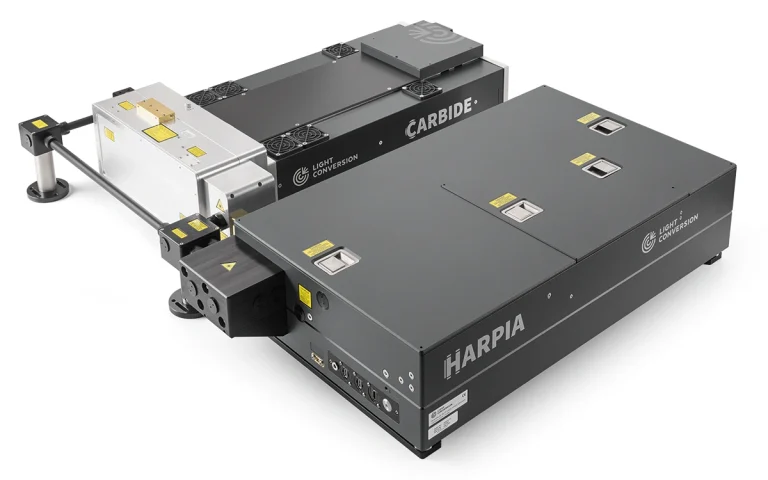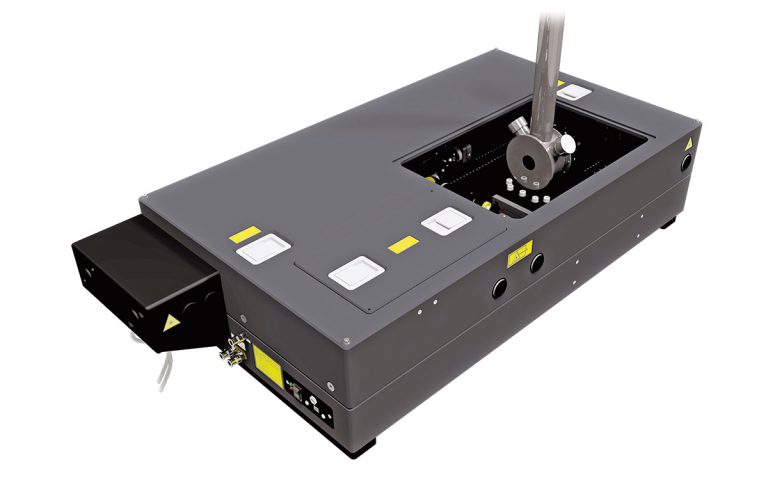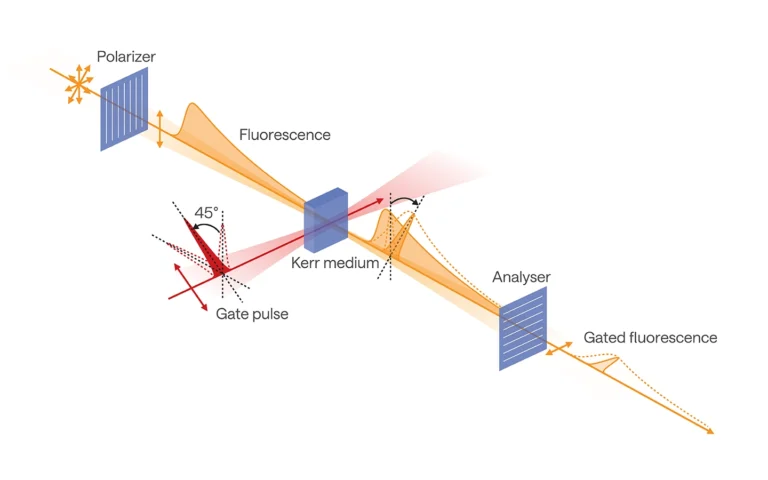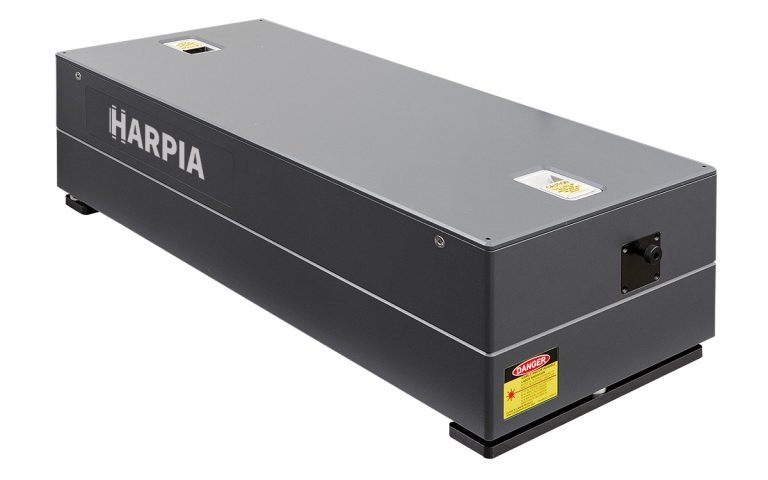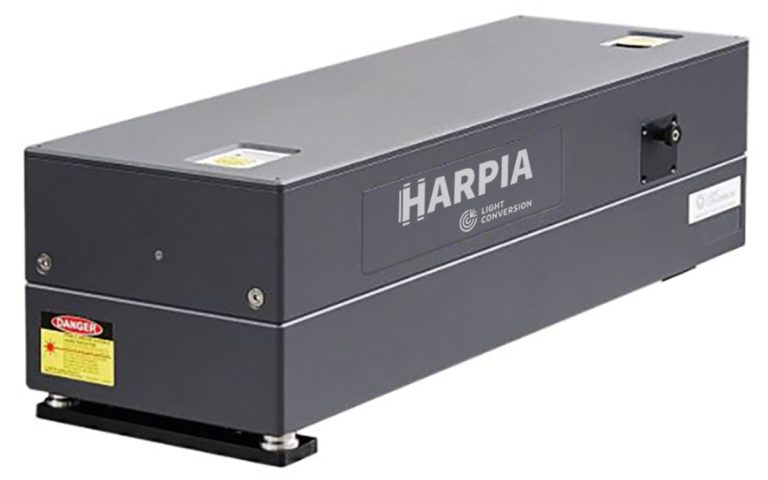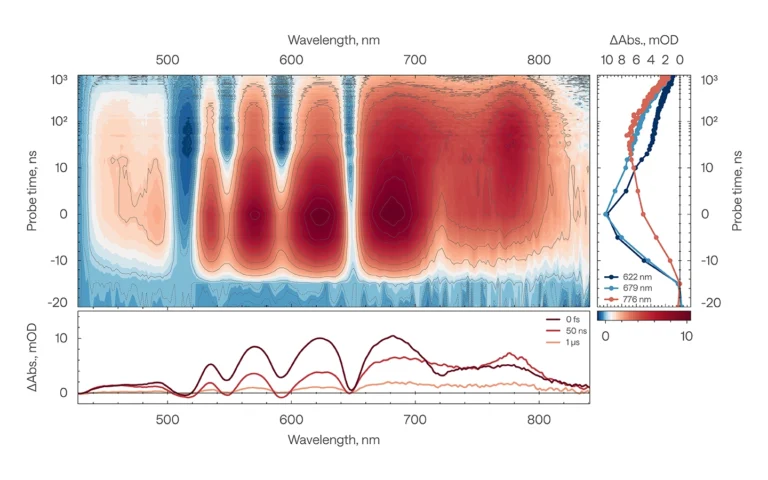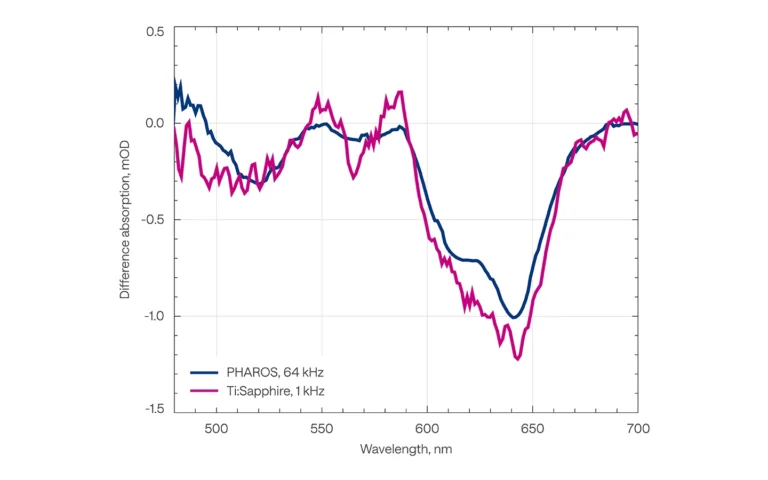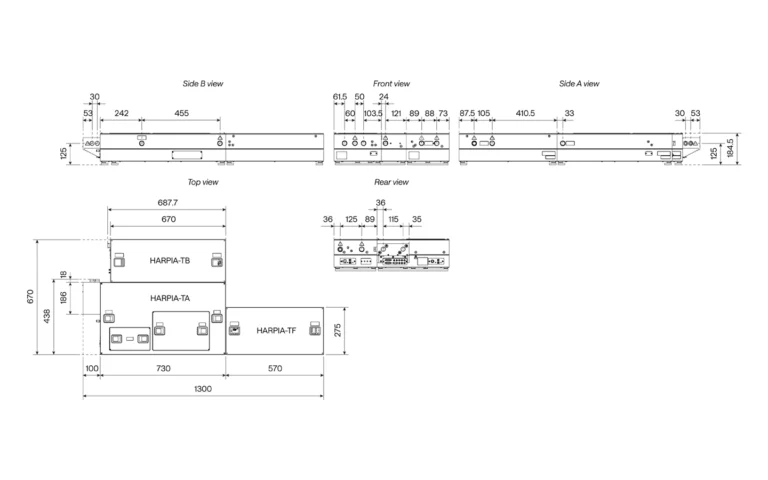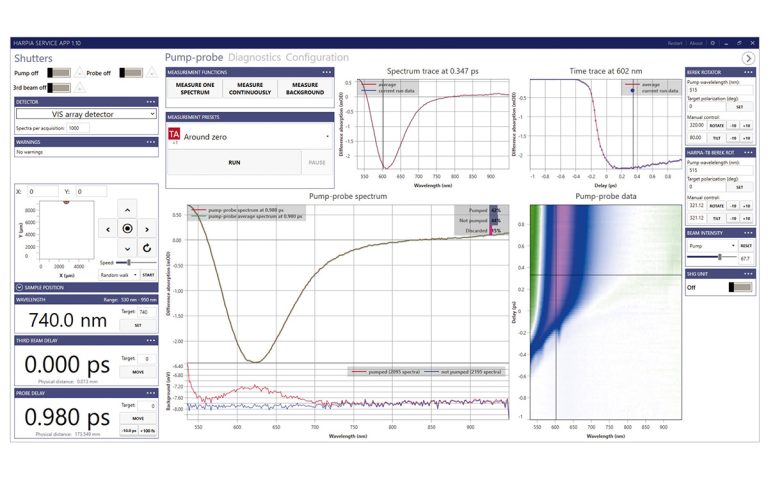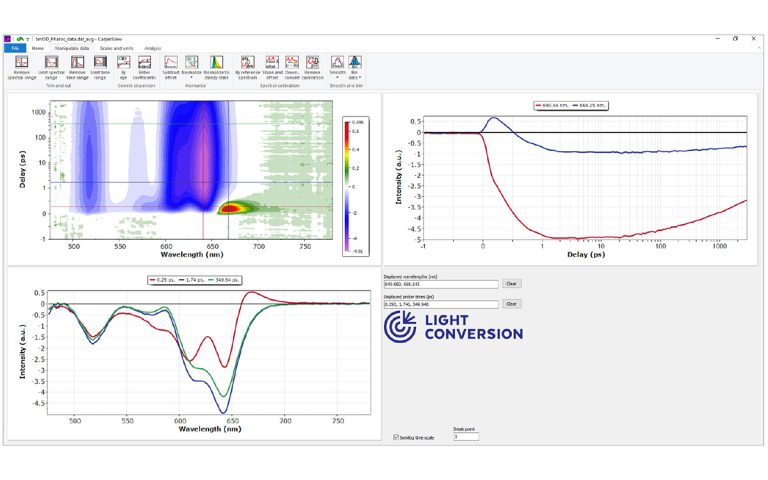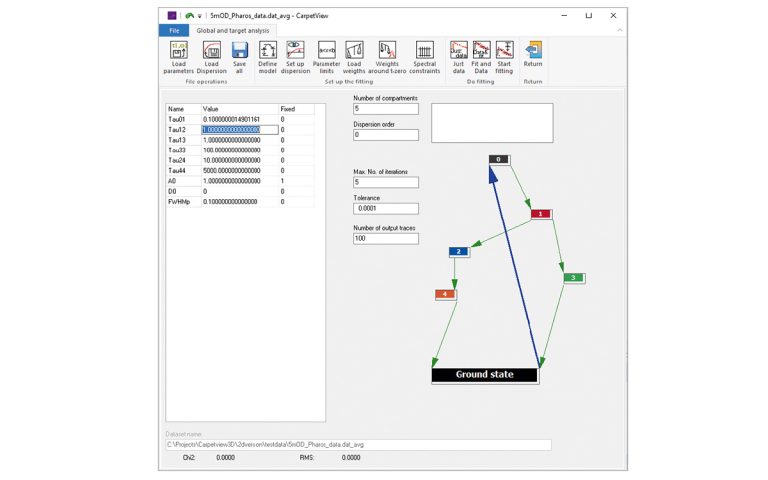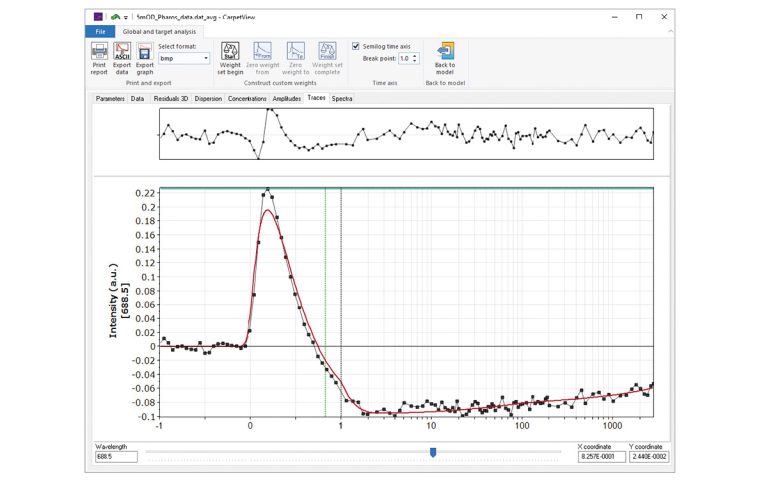The comprehensive HARPIA ultrafast spectroscopy system performs a variety of sophisticated time-resolved spectroscopic measurements within a compact footprint. It offers an intuitive user experience and easy day-to-day maintenance, meeting the needs of today’s scientific applications. Extension modules and customization options tailor the HARPIA system to specific measurement needs.
The system is built around the HARPIA-TA transient absorption spectrometer and can be expanded with additional modules, including time-correlated single-photon counting, Kerr gate, and fluorescence upconversion (HARPIA-TF), and third beam delivery (HARPIA-TB). HARPIA is designed for seamless switching between measurement modes and includes dedicated data acquisition and analysis software. Each module is housed in a monolithic aluminum body, ensuring excellent optical stability and minimal optical path lengths.
For a single-supplier solution, the HARPIA ultrafast spectroscopy system can be paired with a CARBIDE or PHAROS femtosecond laser alongside ORPHEUS series OPAs. HARPIA also supports Ti:sapphire lasers with TOPAS series OPAs.
Applications
- Transient absorption and reflection
- Multi-pulse transient absorption in transmission
- Time-resolved fluorescence: Femtosecond fluorescence upconversion, Kerr gate, TCSPC
- Femtosecond stimulated Raman scattering (FSRS)
- Intensity-dependent transient absorption and reflection
- Flash photolysis – nanosecond transient absorption
Processes Explored by Ultrafast Spectrocopy
- Electron or proton transfer
- Solvation
- Vibrational relaxation
- Exciton energy transfer
- Photoreaction dynamics
| Configuration | UV-VIS | UV-VIS-NIR | MIR |
|---|---|---|---|
| Probe spectral range | 350 – 1100 nm 1) | 350 – 1600 nm 1) | 2000 – 13000 nm 2) |
| Pump range | 240 – 2200 nm 2) | 240 – 2200 nm 2) | 450 – 2200 nm 3) |
| Pump range | 240 – 2200 nm 2) | 450 – 2200 nm 3) | |
| Delay range (resolution) | 8 ns (8.3 fs) | 8 ns (8.3 fs) | 4 ns (4.2 fs) |
| Delay range (resolution) | 8 ns (8.3 fs) | 4 ns (4.2 fs) | |
| Temporal resolution | ≤ laser pulse duration or better | ≤ laser pulse duration or better | ≤ laser pulse duration or better |
| Temporal resolution | ≤ laser pulse duration or better | ||
| Laser repetition rate | 1 – 100 kHz | 1 – 100 kHz | 1 – 100 kHz |
| Laser repetition rate | 1 – 100 kHz | ||
| Maximum data acquisition rate | 3850 Hz | 3850 Hz | 3850 Hz |
| Maximum data acquisition rate | 3850 Hz | ||
| Modes | Reflection and transmission | Reflection and transmission | Reflection and transmission |
| Modes | Reflection and transmission | ||
| Configuration | UV-VIS | UV-VIS-NIR | MIR |
|---|
- Pump–probe measurements using Yb-based laser systems may exhibit blind spots at 515 nm and 1030 nm, corresponding to the second harmonic and the fundamental wavelength of the laser, where strong pump scattering can interfere with accurate detection.
- The range is determined by the OPA’s output spectrum.
- The wavelength range is configurable to 240 – 700 nm. Contact sales@lighton.com for more details.
| Module | HARPIA-TA-FP | HARPIA-TA-FP | HARPIA-TA-FP-UV | HARPIA-TA-FP-UV |
|---|---|---|---|---|
| Module | HARPIA-TA-FP | HARPIA-TA-FP-UV | ||
| HARPIA-TA configuration | UV-VIS | UV-VIS-NIR | UV-VIS | UV-VIS-NIR |
| Probe spectral range 1) | 450 – 1100 nm | 450 – 1600 nm | 350 – 1100 nm | 350 – 1600 nm |
| Pump range | 240 – 2200 nm 2) | 240 – 2200 nm 2) | 240 – 2200 nm 2) | 240 – 2200 nm 2) |
| Pump range | 240 – 2200 nm 2) | |||
| Delay range | up to 485 μs 3) | up to 485 μs 3) | up to 485 μs 3) | up to 485 μs 3) |
| Delay range | up to 485 μs 3) | |||
| Temporal resolution | 2 ns | 2 ns | 1 ns | 1 ns |
| Temporal resolution | 2 ns | 1 ns | ||
| Probe laser repetition rate | 1850 Hz | 1850 Hz | 1850 Hz | 1850 Hz |
| Probe laser repetition rate | 1850 Hz | |||
| Maximum data acquisition rate | 3850 Hz | 3850 Hz | 3850 Hz | 3850 Hz |
| Maximum data acquisition rate | 3850 Hz | |||
| Mode | Reflection and transmission | Reflection and transmission | Reflection and transmission | Reflection and transmission |
| Mode | Reflection and transmission | |||
| Module | HARPIA-TA-FP | HARPIA-TA-FP | HARPIA-TA-FP-UV | HARPIA-TA-FP-UV |
|---|---|---|---|---|
| Module | HARPIA-TA-FP | HARPIA-TA-FP-UV | ||
- Pump–probe measurements using nanosecond laser systems may exhibit blind spots at 1064 nm, corresponding to the fundamental wavelength of the laser.
- The Range is determined by the OPA’s output spectrum.
- A longer delay range is possible with the HARPIA-TA-FP configuration (up to 8 ms). Contact sales@lightcon.com for more details.
| Measurement technique | Kerr gate | Fluorescence upconversion | TCSPC |
|---|---|---|---|
| Spectral range | 380 – 1000 nm | 330 – 820 nm 1) 2) | 220 – 820 nm 3) |
| Pump range | 240 – 2200 nm 4) | 240 – 2200 nm 4) | 240 – 2200 nm 4) |
| Pump range | 240 – 2200 nm 4) | ||
| Temporal resolution | ≥ 1 ps | ≤ 1.4 x laser pulse duration | < 180 ps or < 50 ps |
| Delay range (resolution) | 8 ns (8.3 fs) | 8 ns (8.3 fs) | 5 μs 5) |
| Delay range (resolution) | 8 ns (8.3 fs) | 5 μs 5) | |
| Compatible with | TCSPC | TCSPC | Kerr gate or fluorescence upconversion |
| Compatible with | TCSPC | Kerr gate or fluorescence upconversion | |
| Detector | CCD | PMT | PMT |
| Detector | CCD | PMT | |
| Modes | Transmission | Transmission | Reflection and transmission |
| Modes | Transmission | Reflection and transmission | |
| Measurement technique | Kerr gate | Fluorescence upconversion | TCSPC |
|---|
- The fluorescence detection range is extendable up to 1600 nm. Contact sales@lightcon.com for more details.
- Fluorescence detection may exhibit blind spots at 343 nm, 515 nm, and 1030 nm due to harmonic overlap.
- The spectral range is extendable with an additional NIR detector (measurement range 1000 – 1700 nm). Contact sales@lightcon.com for more details.
- The range is determined by the OPA’s output spectrum.
- Using FIFO-based acquisition, the temporal window can be extended up to ~1 s for monitoring longer-timescale processes.
| Measurement technique | Pump for multi-pulse experiments | FSRS1) |
|---|---|---|
| Probe spectral range | depends on the HARPIA-TA configuration | 350 – 1100 nm 2) |
| Raman spectral range | n/a | 700 – 2000 cm‑1 |
| Acceptable wavelength range | 450 – 2200 nm 3) | |
| Delay range (resolution) | 4 ns (4.2 fs) | 4 ns (4.2 fs) |
| Delay range (resolution) | 4 ns (4.2 fs) | |
| Modes | Transmission | Transmission |
| Modes | Transmission | |
| Measurement technique | Pump for multi-pulse experiments | FSRS1) |
|---|
- The results were obtained using a specific system configuration: a PHAROS femtosecond laser, an ORPHEUS-HE OPA, and an SHBC combined with an ORPHEUS-PS OPA. Measurements were performed at a 10 kHz repetition rate with a 540 nm actinic pump and a 450 nm Raman pump. β-carotene was used as the sample. Contact sales@lightcon.com for more details.
- The system may exhibit blind spots at 515 nm and 1030 nm, corresponding to the second harmonic and fundamental wavelength of the laser, where strong pump scattering can interfere with accurate detection.
- The wavelength range is configurable to 240 – 700 nm. Contact sales@lightcon.com for more details.
| Model | Physical dimensions (L × W × H) 1) |
|---|---|
| HARPIA-TA | 730 × 420 × 183 mm |
| HARPIA-TA sample chamber area (L × W) | 205 × 216 mm |
| HARPIA-TF | 571 × 275 × 183 mm |
| HARPIA-TB | 670 × 252 × 183 mm |
| Model | Physical dimensions (L × W × H) 1) |
|---|
- Without an external spectrograph.
HARPIA-TA ultrafast transient absorption spectrometer provides pump-probe measurement functionality as part of the HARPIA spectroscopy system. The complete system ensures excellent optical stability and minimal optical paths for interacting beams.
HARPIA can be seamlessly integrated with PHAROS or CARBIDE femtosecond lasers, along with ORPHEUS series OPAs for pumping. The high repetition rate of these laser systems enables the study of transient absorption dynamics while exciting the samples with extremely low pulse energies, down to several nanojoules. With broadband probe options, the system covers a wide measurement range from UV to NIR. Additionally, configuring HARPIA-TA with a second OPA for MIR extends its measurement range up to 13 µm when using a single-wavelength detector.
HARPIA-TA offers a variety of features, including an 8 ns optical delay line, pump polarization and intensity control, sample movement positioning, easy supercontinuum generator switching, and straightforward switching between transient absorption and transient reflection measurements.
HARPIA-TA is compatible with various accessories, including cryostats, and peristaltic pumps, and its capabilities can be further extended with additional modules.
The flash photolysis experiment is designed to measure the long-lived states of molecular systems. Its principle is analogous to the femtosecond transient absorption (TA) experiment but with a delay in the nanosecond to millisecond range.
In femtosecond transient absorption, the delay between pump and probe pulses is controlled by moving a mechanical delay stage. In contrast, flash photolysis employs a delayed probe pulse generated by an electronically triggered external probe laser – a broadband nanosecond photonic crystal fiber (PCF) laser.
Time-resolved fluorescence spectroscopy provides valuable insights into molecular processes occurring in the excited states. The HARPIA-TF module combines different measurement modes, enabling the observation of fluorescence dynamics across different time scales. By employing high-repetition-rate PHAROS or CARBIDE lasers, fluorescence dynamics can be measured while exciting the samples with pulse energies as low as several nanojoules.
Modes
- Kerr gate
Ideal for femtosecond fluorescence measurements. Simpler alignment and maintenance. The entire spectrum is measured at once.
- Fluorescence upconversion (FU)
Better temporal resolution for measuring fast fluorescence events.
- Time-correlated single-photon counting (TCSPC)
Fluorescence lifetime measurements are extendible to measure phosphorescence signals.
When standard spectroscopy tools are not enough to unravel the intricate ultrafast dynamics of photoactive systems, multi-pulse time-resolved spectroscopic techniques can provide deeper insights. The HARPIA-TB module enables the introduction of an additional temporally delayed laser pulse (up to 4 ns) before or during the pump-probe interaction to perturb the ongoing photodynamics.
The HARPIA-TB module includes:
- A Berek compensator for polarization control.
- A continuously variable neutral density filter for automated intensity control.
- A delay line with a range of up to 4 ns.
Measurement Modes
- Femtosecond Stimulated Raman Scattering (FSRS)
Delivering frequency-narrowed picosecond pulses enables FSRS measurements, a relatively recent yet increasingly adopted time-resolved spectroscopy technique for observing changes in the vibrational structure of optically excited molecular systems.
- Multi-Pulse Time-Resolved Transient Absorption
Enables control over photochemical reactions and access to higher excited states. Precisely timed pulse sequences can initiate a photoreaction and perturb it at defined moments during its evolution. In some cases, an additional pump pulse can re-excite molecules, with the delay between several pump pulses influencing the reaction’s outcome.
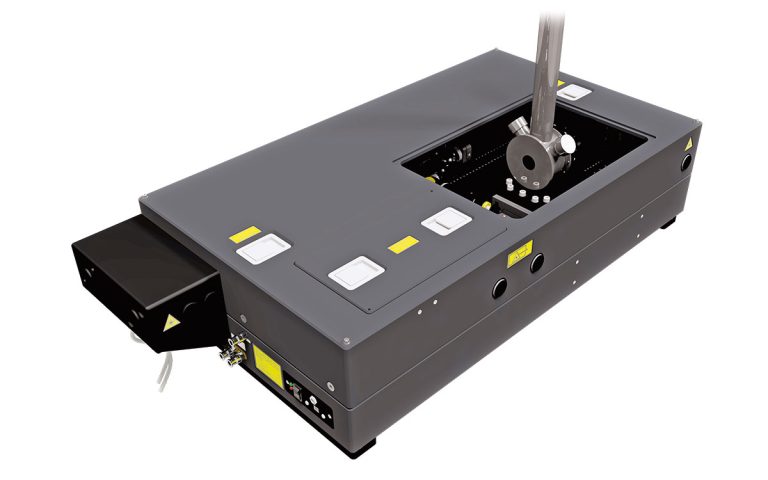
Cryostat mounting.
HARPIA-TA supports cryostats that can be mounted externally or internally.
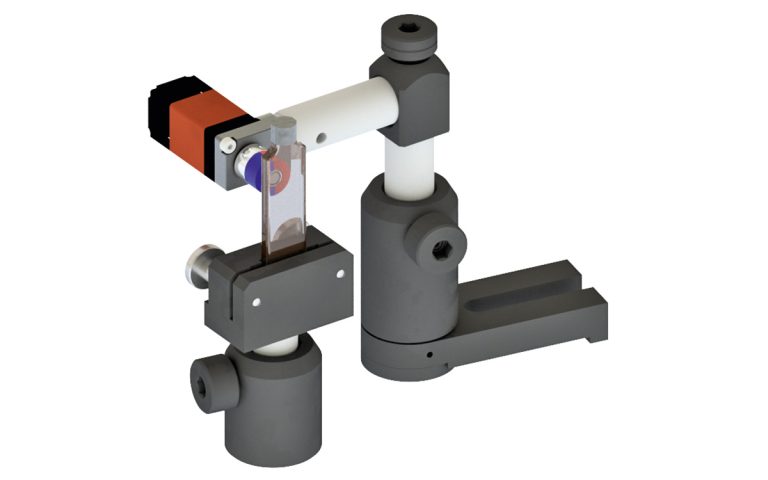
Sample stirrer.
Liquid samples are mixed to prevent overexposure and ensure a fresh sample for each measurement.

Motorized pump mirror.
Used to automatically optimize pump and probe overlap.

External beam steering.
Used to lock the optical beam paths for OPA wavelenghts (350 – 1100 nm).

Beam profiler.
Used to check the beam shape and size at any position before or after measurement inside HARPIA.
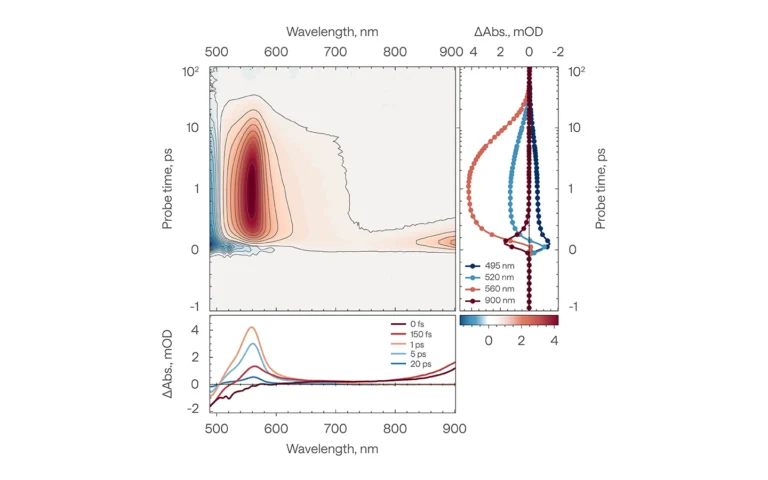
Spectral dynamics of β-carotene in solution, acquired using the HARPIA-TA transient absorption spectrometer.
Measurement conditions: 100 kHz repetition rate, 490 nm pump wavelength, < 10 nJ pump pulse energy, 13 s per spectrum (per delay point) acquisition time.

Pump-probe dynamics of a GaAs wafer in the IR, acquired using signal and reference single-channel detectors of the HARPIA-TA transient absorption spectrometer.
Measurement conditions: 75 kHz repetition rate, 700 nm pump wavelength, 1 s per point acquisition time.

Kerr gate measurements in DCM illustrate the method’s ability to probe fluorescence evolution with sub-picosecond temporal resolution.
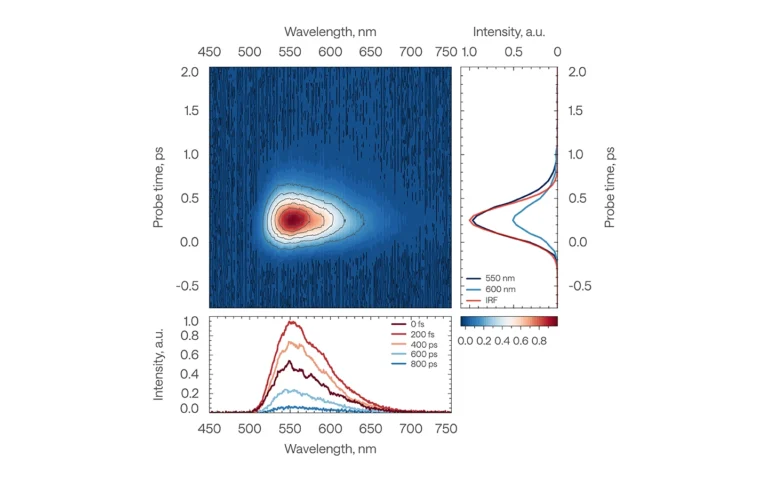
Kerr gate measurements in β-carotene generally showcase the resolution of the measurement. The S₂→S₀ fluorescence of carotenoids is ultrafast (<100 fs), therefore, the measured data is mainly IRF-limited.

Fluorescence dynamics of DCM laser dye in solution, acquired using the HARPIA-TF time-resolved fluorescence module in fluorescence upconversion mode.
Measurement conditions: 100 kHz repetition rate, 430 nm pump wavelength.

Fluorescence dynamics of DCM laser dye in solution, acquired using the HARPIA-TF time-resolved fluorescence module in TCSPC mode.
Measurement conditions: 100 kHz repetition rate, 430 nm pump wavelength.
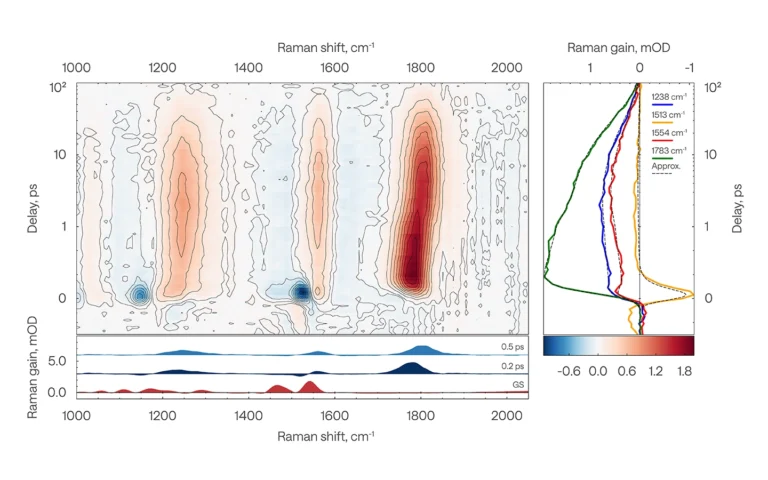
FSRS dynamics of neoxanthin, acquired using the HARPIA-TB third beam delivery module.
Measurement conditions: 25 kHz repetition rate, 440 nm actinic pump wavelength, 200 nJ pulse energy, 530 nm Raman pump wavelength, 300 nJ pulse energy.

Pump-dump-probe dynamics of DCM laser dye, acquired using the HARPIA-TB third beam delivery module, with the dump pulse resonant to the emission band of DCM.
Measurement conditions: 50 kHz repetition rate, 515 nm pump wavelength, 700 nm dump wavelength, 21 ps dump delay, 90 nJ pump pulse energy, 190 nJ dump pulse energy.
HARPIA performance at high repetition rates
The HARPIA spectroscopy system achieves an excellent signal‑to‑noise ratio (SNR) at high repetition rates and low energy excitation conditions. The graphs below compare the signal-to-noise ratio of difference absorption spectra acquired using a Ti:Sapphire laser operating at 1 kHz and a PHAROS laser operating at 64 kHz with the same acquisition time.

Principle of time-correlated single-photon counting (TCSPC).
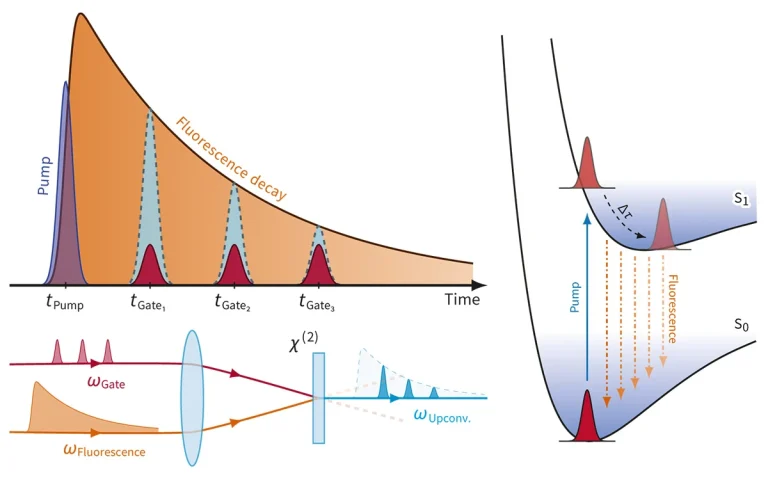
Principle of time-resolved fluorescence upconversion.
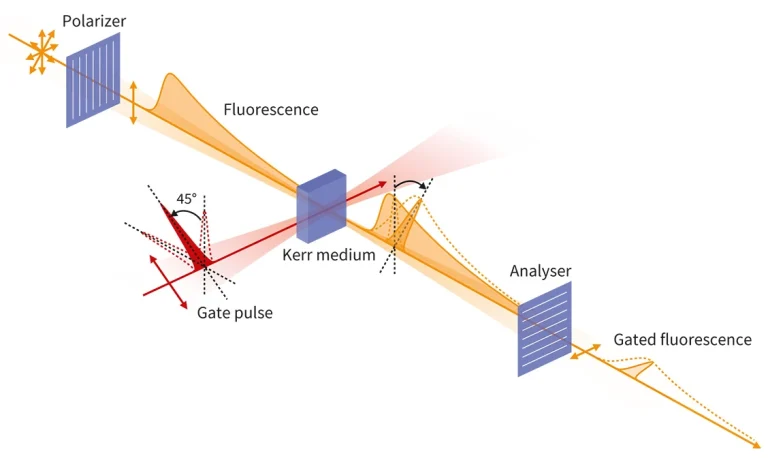
Principle of Kerr gate spectroscopy.

Illustration of state transitions and pulse timing in multi-pulse transient absorption spectroscopy.
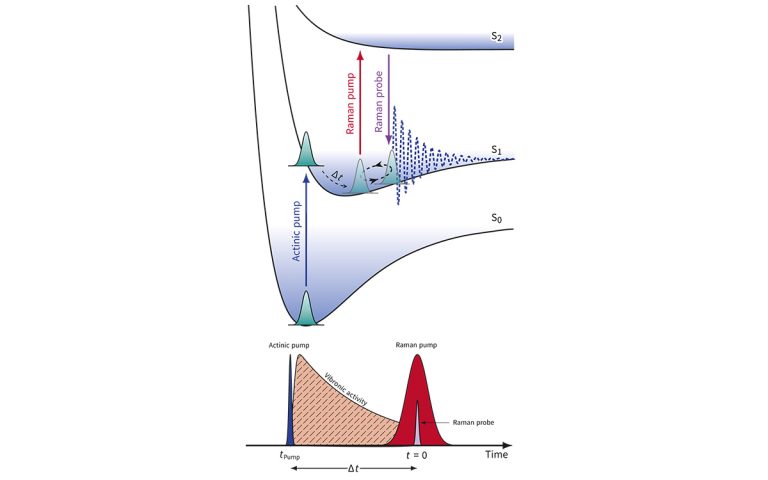
Illustration of femtosecond stimulated Raman scattering (FSRS).
A single software solution for all measurement modes, featuring:
- A user-friendly interface
- Measurement presets
- Measurement noise suppression
- Diagnostics and data export
- Continuous support and updates
- API for remote experiment control using third-party software (LabVIEW, Python, MATLAB)
An ultrafast spectroscopy data analysis software, featuring:
- Advanced data wrangling: slicing, merging, cropping, smoothing, fitting, etc.
- Advanced global and target analysis
- Probe spectral chirp correction, calibration, and deconvolution
- Support for 3D data sets (2D electronic spectroscopy, fluorescence lifetime imaging)
- Publication-ready figure preparation and data export
Product datasheet
Application examples
Product catalog
Product catalog
Product catalog in Chinese
